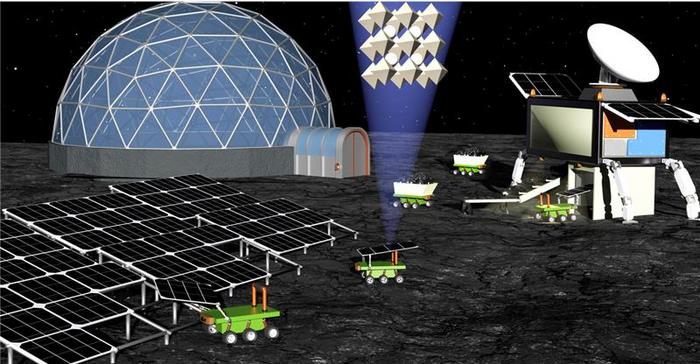Solar power, a staple of space exploration, may soon see a revolutionary transformation thanks to a new study published in the journal Device. Researchers have crafted solar cells from simulated Moon dust, a development that could significantly advance sustainable energy solutions for future lunar settlements.
The concept, spearheaded by Felix Lang and his team at the University of Potsdam, Germany, centers on using lunar regolith—the loose, rocky surface material of the Moon—to produce solar cells. This approach could drastically cut the weight and cost of transporting materials from Earth. “If you cut the weight by 99%, you don’t need ultra-efficient 30% solar cells, you just make more of them on the Moon,” Lang explains. This innovative method could reduce spacecraft launch mass by 99.4% and slash transport costs by 99%, making long-term lunar habitation more feasible.
Current solar cells used in space, while highly efficient, are heavy and expensive due to their reliance on Earth-made glass or thick foils. Lang’s team proposes replacing this with glass made from lunar regolith, which not only reduces weight but also enhances radiation resistance. When exposed to space-grade radiation, the moonglass solar cells outperformed traditional Earth-made versions. This is because standard glass tends to brown in space, reducing its efficiency, whereas moonglass, with its natural brown tint, remains stable and more resistant to radiation.
Creating moonglass is surprisingly straightforward. It requires no complex purification, and the extreme temperatures needed to melt the lunar regolith can be achieved with concentrated sunlight. By adjusting the thickness of the moonglass and optimizing the solar cell composition, the team achieved an efficiency of 10%, with potential to reach 23% with clearer glass.
Despite these promising results, challenges remain. The Moon’s lower gravity might affect how moonglass forms, and the solvents used for processing perovskite, the material paired with moonglass to create the solar cells, are not compatible with the Moon’s vacuum environment. Additionally, the extreme temperature fluctuations on the Moon could threaten the materials’ stability. To address these issues, the team plans to conduct a small-scale experiment on the Moon to test the cells in real lunar conditions.
The broader implications of this research are significant. As Lang notes, “From extracting water for fuel to building houses with lunar bricks, scientists have been finding ways to use Moon dust. Now, we can turn it into solar cells too, possibly providing the energy a future Moon city will need.” This development aligns with the vision of a permanent lunar base powered by the near-constant solar illumination at the lunar south pole.
The study also highlights the potential of combining lunar regolith with halide perovskites, which are cheaper and easier to produce than traditional solar cell materials. This combination allows for the creation of solar cells with high power-per-launched-mass ratios, making them ideal for space applications. The moonglass/perovskite solar cells, with their high radiation tolerance and mechanical stability, could pave the way for sustainable lunar energy solutions.
As space agencies like NASA and private companies continue to plan for lunar exploration and potential colonization, the need for reliable and cost-effective energy sources becomes increasingly critical. The research by Lang and his team offers a promising solution, leveraging the Moon’s own resources to support human habitation and industrial activities.
If our reporting has informed or inspired you, please consider making a donation. Every contribution, no matter the size, empowers us to continue delivering accurate, engaging, and trustworthy science and medical news. Independent journalism requires time, effort, and resources—your support ensures we can keep uncovering the stories that matter most to you.
Join us in making knowledge accessible and impactful. Thank you for standing with us!

